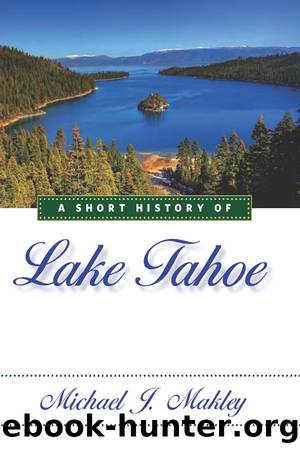A Short History of Lake Tahoe by Michael J. Makley

Author:Michael J. Makley [Makley, Michael J.]
Language: eng
Format: epub
Tags: History, General, United States, State & Local, West (AK; CA; CO; HI; ID; MT; NV; UT; WY), Travel, West, Pacific (AK; CA; HI; OR; WA), Nature, Environmental Conservation & Protection
ISBN: 9780874178661
Google: kmyVDwAAQBAJ
Publisher: University of Nevada Press
Published: 2011-10-13T15:57:43+00:00
Racing continued at the lake into the mid-1960s. For several years Harrah's Club sponsored the only bistate unlimited hydroplane race in the country, and Bill Harrah's Tahoe Miss always contended.
While summer speedboat racing was limited to the well-to-do, and later to those with large corporate sponsors, winter sports were expanding so they might better include the general population. In 1947, at Tahoe City, a Norwegian ski jumper and former sea captain named Kjell âRustyâ Rustad built Granlibakken nearly single-handedly. With a handful of friends he cleared the hill, built a log cabin and a bridge to get across a stream, installed a 450-foot rope to the top, and began hosting the Lake Tahoe Ski Club as well as young locals who would grow up on skis. Meanwhile, Wayne Poulsen had created the Squaw Valley Ski Resort, which opened on Thanksgiving Day 1949. Its main attraction came to be the mountain face dubbed âKT 22.â Poulsen named it after watching his wife, Sandy, an experienced skier, descend utilizing twenty-two kick turns (the KT in the name), one after each traverse of the breathtakingly steep run.
In 1948 Poulsen had recruited an investor from the East, Alex Cushing, to form the Squaw Valley Development Corporation. Shortly before the mountain opened for business, a bitter dispute broke up the partnership. Cushing, who owned 52 percent of the stock, called a stockholders meeting while Poulsen, the president, was out of town and ousted him. Cushing, the company's secretary-treasurer, took over control, and Poulsen never made a cent directly from the resort that had been his dream. Fortunately for Poulsen, he owned a majority of the land on the valley floor, and he did very well in the real estate business. His son said he often heard his father comment, âIt doesn't matter; besides the fish are rising and the skiing is fine. Come on, boys, it's time to go!â
At its opening Squaw Valley comprised a small lodge, one rope tow, and the longest double chairlift in the world. During the first five years of operation, three avalanches ripped out lift towers, there were four bridge washouts, and twice the lodge flooded. Still, in 1954, when Cushing learned that Reno had bid for the 1960 Olympic Games, he thought it would be a great publicity stunt to submit his own bid. He found he needed to make a formal presentation to the Olympic Committee the following month. Working fast, he gained the California governor's assistance and persuaded the state legislature to revive an old bill that promised money for the Los Angeles 1932 Summer Olympics. The legislature amended the outdated bill, guaranteeing one million dollars for the Winter Games. Cushing made his proposal, selling the idea of the uniqueness of a virgin mountain with an annual snowfall of 450 inches.
Although one Olympic Committee member called it âa glorified picnic ground,â Squaw Valley became the U.S. nominee over Lake Placid, Sun Valley, and Aspen. Avery Brundage, the president of the International Olympic Committee, commented that the U.S. committee âobviously has taken leave of their senses.
Download
This site does not store any files on its server. We only index and link to content provided by other sites. Please contact the content providers to delete copyright contents if any and email us, we'll remove relevant links or contents immediately.
The Lonely City by Olivia Laing(4627)
Animal Frequency by Melissa Alvarez(4244)
All Creatures Great and Small by James Herriot(4079)
Walking by Henry David Thoreau(3767)
Exit West by Mohsin Hamid(3692)
Origin Story: A Big History of Everything by David Christian(3529)
COSMOS by Carl Sagan(3423)
How to Read Water: Clues and Patterns from Puddles to the Sea (Natural Navigation) by Tristan Gooley(3305)
Hedgerow by John Wright(3175)
How to Do Nothing by Jenny Odell(3151)
The Inner Life of Animals by Peter Wohlleben(3149)
How to Read Nature by Tristan Gooley(3144)
Project Animal Farm: An Accidental Journey into the Secret World of Farming and the Truth About Our Food by Sonia Faruqi(3078)
Origin Story by David Christian(3053)
Water by Ian Miller(3029)
A Forest Journey by John Perlin(2961)
The Plant Messiah by Carlos Magdalena(2798)
A Wilder Time by William E. Glassley(2738)
Forests: A Very Short Introduction by Jaboury Ghazoul(2719)
